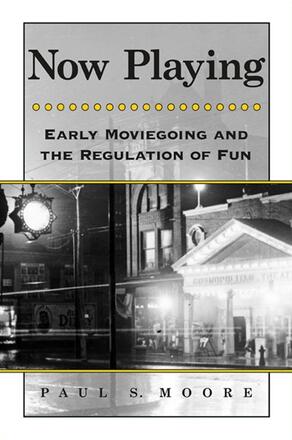
Now Playing
Early Moviegoing and the Regulation of Fun
Alternative formats available from:
Locates the origins of the mass audience and the emergence of everyday moviegoing in the culture of cities.
Description
Winner of the 2009 Gertrude J. Robinson Book Prize presented by the Canadian Communication Association
Using Toronto as a case study, and focusing on a period from the opening of the first theaters showcasing moving pictures in 1906 to the end of World War I, Now Playing locates the origins of our present-day mass audience in the culture of cities. Paul S. Moore examines the emergence of everyday moviegoing and its regulation through neglected details like fire safety, newspaper ads, serial films, and amusement taxes, connecting them to more familiar themes of studio ownership of theaters, censorship, and journalism. In Toronto—a foreign city inside the American mass market—patriotism ultimately comes to the fore as civic forms of showmanship turn the simple act of "going to the movies" into a form of citizenship.
Paul S. Moore is Assistant Professor in Sociology and in the Graduate Program in Communication and Culture at Ryerson University in Toronto.
Reviews
"…Now Playing does more than describe the emergence of cinema in Toronto. By documenting how moviegoing in Toronto became a mass practice, Moore demonstrates that the rapid rise of Hollywood in the late 1910s was not only due to industrial reorganization at the site of film production, but was also the consequence of local changes in film exhibition. " — Journal of Social History
"Writing from his North American viewpoint, Moore's analysis of the filmic image and effects of the Great War in Europe on Canadian audiences in Toronto is fascinating. " — Urban Studies Journal
"Moore's extensive archival research and attention to detail effectively illustrate his claims, in the process revealing fascinating local particularities to early moviegoing in Toronto … Now Playing provides a thorough discussion of a fascinating topic, and will be invaluable to all readers interested in early moviegoing or Toronto during this period. " — Canadian Journal of Urban Research
"The research effort that has gone into this book is commendable. For the period from 1906 to 1918, Paul Moore has scoured government documents, trade publications, religious periodicals, and especially the daily press, looking for any scrap of information about the introduction of motion pictures to Toronto. " — Canadian Journal of Law and Society
"This is an exquisitely researched, shrewdly conceived, and lucidly compelling study. Moore demonstrates that local and regional practices of 'showmanship'—of municipal regulation, newspaper circulation, management strategies, and so on—quite literally produced or constructed a globally oriented sensibility of mass culture. That the author arrives at his conclusions via a rich, archeological methodology that is rooted in the very specific, local practices developing in Toronto in the early twentieth century proves him to be a remarkably astute historian. Indeed, this study offers the best of what might generally be termed 'new' film historical work. " — Jennifer M. Bean, coeditor of A Feminist Reader in Early Cinema
"Paul Moore handles his subject brilliantly. The questions he addresses are crucial for the advancement of our comprehension of early cinema, and the book is a model for pinpoint historical research. " — André Gaudreault, Université de Montréal